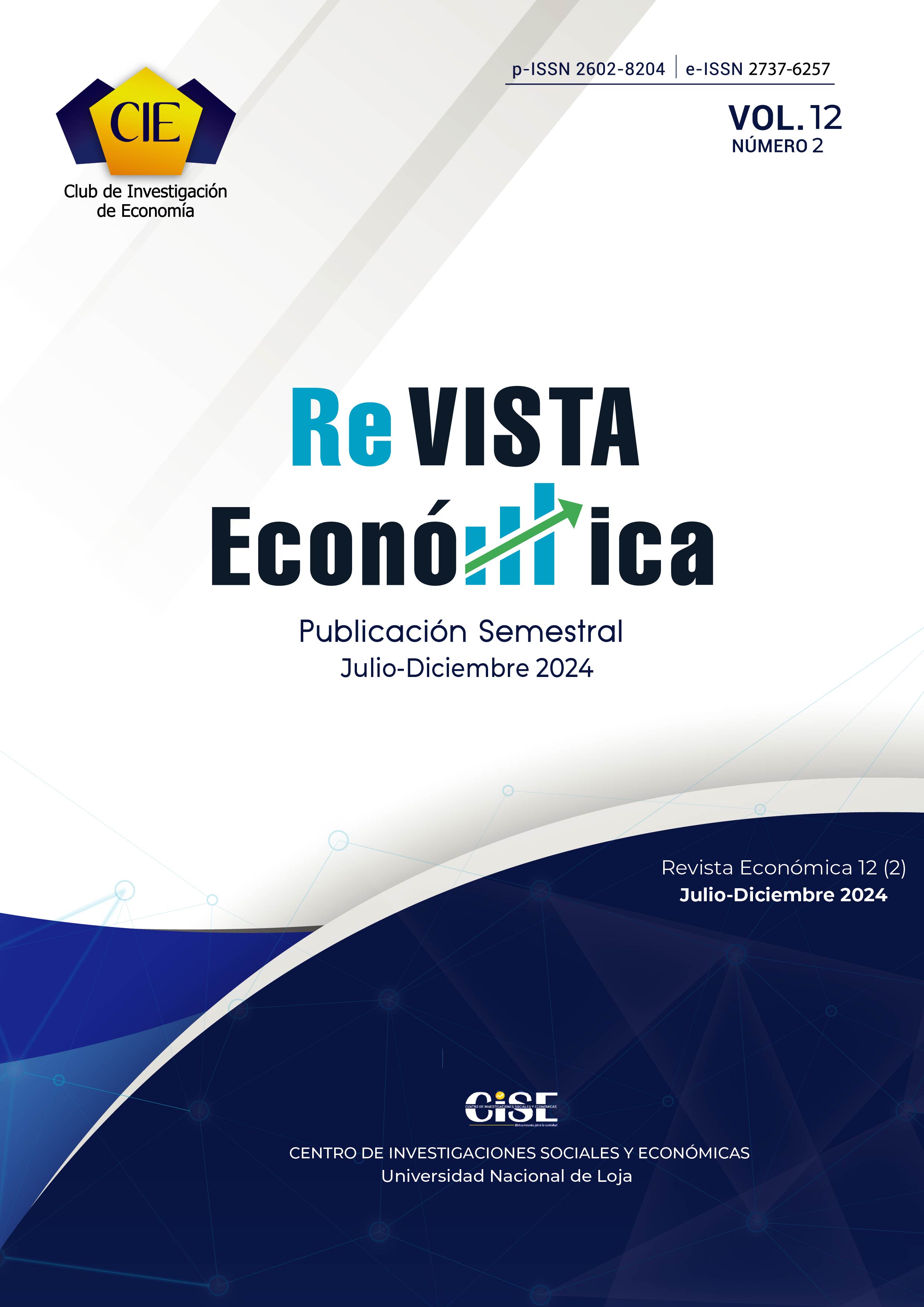Exploring the long-run relationship between labor market and poverty in Argentina
Main Article Content
Abstract
Article Details

This work is licensed under a Creative Commons Attribution-NonCommercial-NoDerivatives 4.0 International License.
Esta obra está sujeta a la licencia Reconocimiento-NoComercial-SinObraDerivada 4.0 Internacional de Creative
Commons. Para ver una copia de esta licencia, visite http://creativecommons.org/licenses/by-nc-nd/4.0/.
References
Agénor, P. R. (2004). Macroeconomic adjustment and the poor: analytical issues
and cross country Evidence. Journal of Economic Surveys, 18 (3), 351-408.
Beccaria, L., Groisman, F. y Monsalvo, P. (2006). Segmentación del Mercado de Trabajo y Pobreza en Argentina. Asociación Argentina de Economía Política. Disponible en https://aaep.org.ar/anales/works06/Beccaria_Groisman_Monsalvo.pdf.
Beccaria, L., y Groisman, F. (2009). Informalidad y pobreza: una relación compleja. Argentina desigual, 95-155
Beccaria, L., Maurizio, R., Fernández, A. L. y Monsalvo, A. L. (2011). Dynamics of Poverty, labor Market and Public Policies in Latin America. Poverty and Economic Policy Research Network. PMMA Working Paper 2011-0.
Beker, Victor A. (2016). Growth, Inequality and Poverty: What Do We Know?
Blanco, V., Cristina, A.D., Figueras, A. & Iturralde, I. (2022). Convergencia y flexibilidad de los salarios en Argentina. Economic Analysis Review (en prensa).
Bod’a, M., & Považanová, M. (2021). Output-unemployment asymmetry in Okun coefficients for OECD countries. Economic Analysis and Policy, 69, 307-323.
Bourguignon, F. (2004). The Poverty-Growth-Inequality Triangle. The World Bank. Indian Council for Research on International Economic.
Chudik, A., and M. H. Pesaran. (2015). Large panel data models with cross-sectional dependence: A survey. In The Oxford Handbook Of Panel Data, ed. B. H. Baltagi, 2–45. Oxford: Oxford University Press.
Cruces, G., Fields, G., Jaume, D. y Viollaz, M. (2017). Growth, Employment, and Poverty in Latin America, Oxford University Press.
Ditzen, J. (2018). xtdcce2: Estimating dynamic common correlated effects in Stata. The Stata Journal, 18:3, 585 - 617.
Ditzen, J. (2021). Estimating long run effects and the exponent of cross-sectional dependence: an update to xtdcce2. The Stata Journal 21:3.
Fosu, A. K. (2017). Growth, Inequality and Poverty Reduction in Developing Countries: Recent Global Evidence. Research in Economics. 71(2) 306-336
Gasparini, L., Gutiérrez, F., & Tornarolli, L. (2007). Growth and income poverty
in Latin America and the Caribbean: evidence from household surveys. Review of Income and Wealth, 53(2), 209-245
Gasparini, L., Tornarolli, L., & Gluzmann, P. (2019). El desafío de la pobreza en Argentina. Diagnóstico y perspectivas. CIPEC, PNUD y CEDLAS.
Gertel,H., Cristina, D & Navarrete, J. (2011). Diagnóstico y Estrategias de Mediano y Largo Plazo en Trabajo y Empleo. En Kesman (editor), COPEC.
Halac, M., & Schmuckler, S. (2004). Distributional Effects of Crises: the financial channel. Economía, Journal of LACEA, 5(1), 1-67.
Levin, A., C.-F. Lin, and C.-S. J. Chu. (2002). Unit root tests in panel data: Asymptotic and finite-sample properties. Journal of Econometrics 108: 1–24. https://doi.org/10.1016/S0304-4076(01)00098-7.
López, H. y Servén, L. (2006). A Normal Relationship? Poverty, Growth and Inequality. Policy Research. Working Paper Series. Banco Mundial.
Im, K. S., Pesaran M. H. and Shin, Y. (2003). Testing for unit roots in heterogeneous panels. Journal of Econometrics 115: 53–74. https://doi.org/10.1016/S0304-4076(03)00092-7.
Marrero, G. y Servén L. (2022). Growth, inequality and poverty: a robust relationship? Empirical Economics 63:725–791 https://doi.org/10.1007/s00181-021-02152-x
Mario, A., y García, A. (2013). Informalidad laboral, pobreza y regiones. Un análisis desde la coyuntura Argentina. Revista de estudios regionales y mercado de trabajo, (9), 107-125. Disponible en: http://www.memoria.fahce.unlp.edu.ar/art_revistas/pr.6298/pr.6298.pdf
Moreno, D. C. G., Gómez, M. Á. M., Muñoz, V. E. S., & Pereira, J. G. S. (2021). Crecimiento y desempleo en Ecuador: Enfoque asimétrico de la Ley de Okun. ECA Sinergia, 12(1), 27-42.
Navarrete, J. L.; Cristina, Daniela; Blanco, Valeria; y Reyes, Lujan (2021) Mercado laboral y pobreza en Argentina. Revista de Economía y Estadística. Vol LIX, N°1, pp 85-123. https://revistas.unc.edu.ar/index.php/REyE.
Pedroni, P. (1999). Critical values for cointegration tests in heterogeneous panels with multiple regressors. Oxford Bulletin of Economics and Statistics 61: 653–670.
Pedroni, P. (2004). Panel cointegration: Asymptotic and finite sample properties of pooled time series tests with an application to the PPP hypothesis. Econometric Theory 20: 597–625. https://doi.org/10.1017/S0266466604203073
Pesaran M.H. y Smith R. (1995) Estimating long-run relationships from dynamic heterogeneous panels. Journal of Econometrics, 68(1),79–113
Pesaran M.H., Shin Y. y Smith R.P. (1999) Pooled mean group estimation of dynamic heterogeneous panels. Journal of the American Statistical Association, 94(446), 621–634
Pesaran, M. H. (2007). A simple panel unit root test in the presence of cross‐section dependence. Journal of Applied Econometrics, 22(2), 265-312.
Pesaran, M. H. y Yamagata T. (2008). Testing slope homogeneity in large panels. Journal of Econometrics, 142 (1), 50-93.
Pesaran, M. H. (2015). Testing weak cross-sectional dependence in large panels. Econometric Reviews, 34, 1089–1117.
Porras, S., y Martín-Román, Á. L. (2020). Relación entre las características de los mercados de trabajo latinoamericanos y la ley de Okun. Serie Documentos de Trabajo 10(20).
Reyes, Luján (2022). Análisis de los determinantes de la pobreza monetaria en Argentina en el periodo 2003-2019. Perspectivas Revista de Ciencias Sociales. 7(14), 705-728
Sconfienza, M. E. (2017). Pobreza y Acceso al Empleo en Argentina ¿Cómo se Relacionan Demanda e Inclusión Laboral?. Revista de Ciencias Sociales (CR), 4(158). Disponible en https://www.redalyc.org/pdf/153/15354921007.pdf.
Shin, Y., Yu, B., Greenwood-Nimmo, M. (2014). Modelling Asymmetric Cointegration and Dynamic Multipliers in a Nonlinear ARDL Framework. In: Sickles, R., Horrace, W. (eds) Festschrift in Honor of Peter Schmidt. Springer, New York, NY. https://doi.org/10.1007/978-1-4899-8008-3_9
Westerlund, J. (2005). New simple tests for panel cointegration. Econometric Reviews, 24, 297–316. https://doi.org/10.1080/07474930500243019.
Zack, G., y Sotelsek, D. (2019). The Asymmetric Effect of the Bussiness Cycle on Poverty in Argentina. Panoeconomicus, 66(3), 347-364.
Zack, G., Schteingart, D. y Favata, F. (2020). Pobreza e indigencia en Argentina: construcción de una serie completa y metodológicamente homogénea. Sociedad y Economía, (40), 69-98. https://doi.org/10.25100/sye.v0i40.8020
Zanin, L. (2021). On the estimation of Okun’s coefficient in some countries in Latin America: a comparison between OLS and GME estimators. Empirical Economics, 60(3), 1575-1592.

